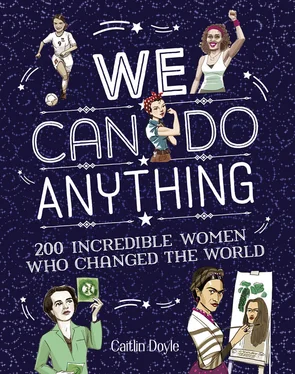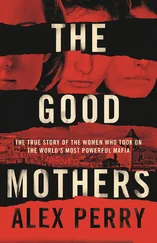Within these pages, I have included more than 200 incredible women who I believe to have been at the top of their game within their chosen fields. However, there are simply not enough pages to include every great individual, and the selection I have made is limited by my own research and subjectivity. I invite you to include your own “greats” within the pages of this book. You will find blank pages at the end of each chapter, where you can add the names and details of the women who really mean something to you—be they big names from history, or current affairs, or people from your own life who have inspired and amazed you. Make this book your own.
Caitlin Doyle
June 2016
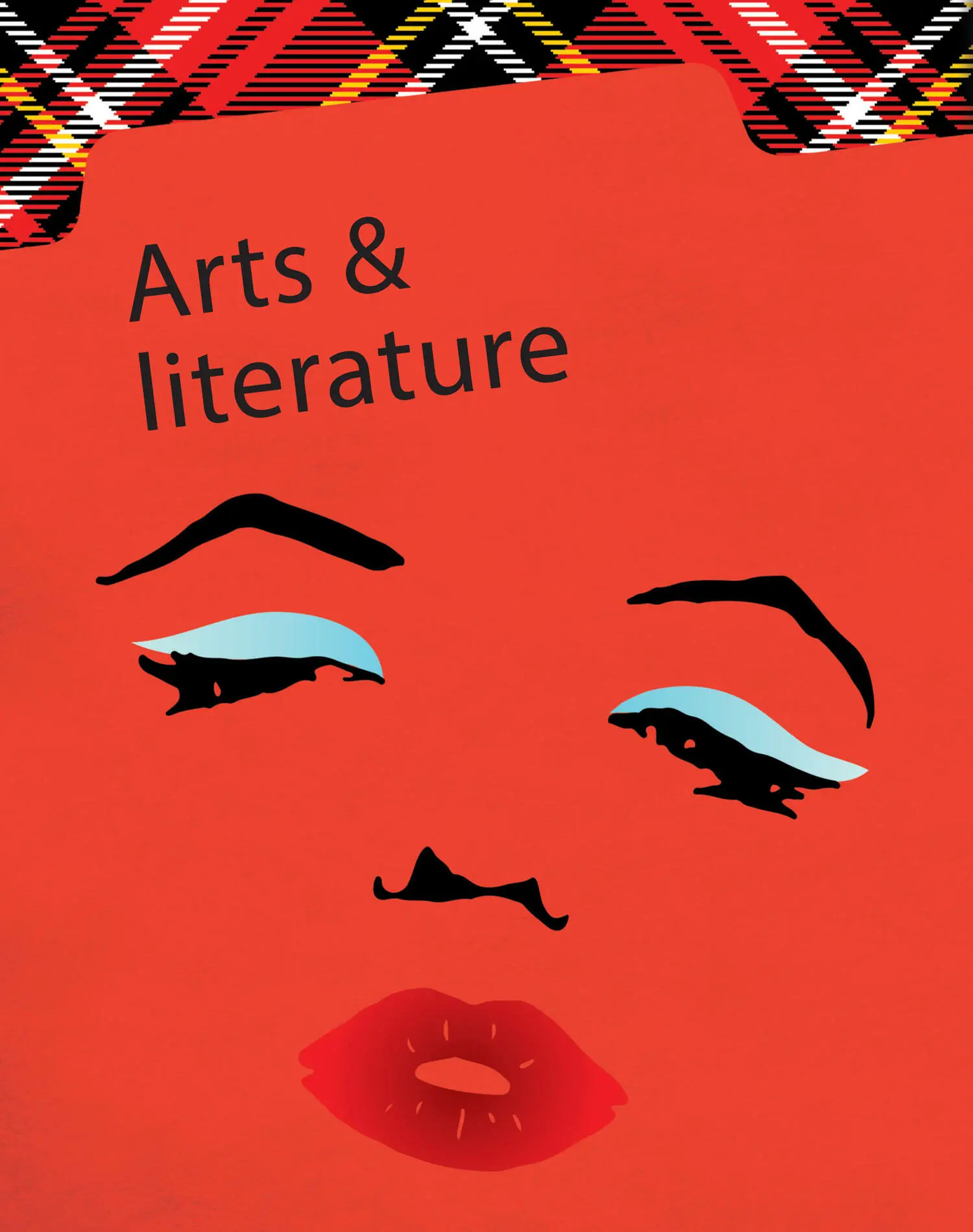
CONTENTS
SAPPHO
MURASAKI SHIKIBU
SAINT HILDEGARD OF BINGEN
THE MONA LISA
ARTEMISIA GENTILESCHI
APHRA BEHN
COUNTESS D’AULNOY
FAIRY TALES
JUANA INÉS DE LA CRUZ
JULIA MARGARET CAMERON
BEATRIX POTTER
VIRGINIA WOOLF
COCO CHANEL
MA RAINEY
GEORGIA O’KEEFFE
DOROTHEA LANGE
ANNI ALBERS
FEATURE: WOMEN IN PHOTOGRAPHY
MARGARET BOURKE-WHITE
JOSEPHINE BAKER
KATHARINE HEPBURN
FRIDA KAHLO
GINGER ROGERS
FEATURE: FUNNY WOMEN
LUCILLE BALL
SISTER ROSETTA THARPE
BILLIE HOLIDAY
ÉDITH PIAF
ELLA FITZGERALD
PHYLLIS DILLER
MARGOT FONTEYN
MARIA CALLAS
MARILYN MONROE
MAIJA ISOLA
YAYOI KUSAMA
AUDREY HEPBURN
DELIA DERBYSHIRE
FEATURE: WOMEN IN MUSIC
DOLLY PARTON
MERYL STREEP
ANNA WINTOUR
FEATURE: FEMALE FASHION-SETTERS
OPRAH WINFREY
MADONNA
EVELYN GLENNIE
J.K. ROWLING
FEATURE: WOMEN OF LETTERS
THE NIGHTINGALES
BEYONCÉ
MISTY COPELAND
SAPPHOONE OF THE GREATEST POETS OF ANTIQUITY
FULL NAME: Sappho
BORN: C. 620 B.C., LESBOS, GREECE
DIED: 550 B.C., LESBOS, GREECE
NATIONALITY: ANCIENT GREEK
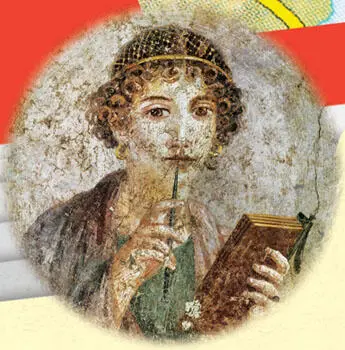
A poetess, believed to be Sappho, from an ancient Roman fresco
“Beauty endures only for as long as it can be seen; goodness, beautiful today, will remain so tomorrow.”
SAPPHO
THE POETESS
Sappho, or Psappha, is often simply referred to as “the Poetess”—so great was her talent. Her fame is considerable, especially as very little is known about the woman herself.
Sappho spent most of her life on the Greek island of Lesbos and is believed to have been born to an aristocratic family. She is said to have married and had a daughter, but any details of this are scarce. Sappho wrote many songs and poems and is considered to be one of the greatest of the ancient poets.
BEAUTY ENDURES
Little remains of Sappho’s work, but scholars continue to be fascinated by her. Newly discovered poems have been published as recently as 2014. Her poetry and songs were written in a unique style, now called “Sapphic” meter. The language was simple and direct, but full of melody.
Often Sappho wrote about beauty and love—sometimes addressing her poems to men but more often to women. In fact, her name (as an adjective, “Sapphic”) is used to describe romantic love between women, as is the island where she was born (“lesbian” comes from “Lesbos”). She wrote odes to the goddesses and retellings of Greek myths. She also wrote about her community and, it is believed, herself. This was different from the male poets of the time, who tended to focus on politics.
In spite of the fact that Sappho lived over 2,000 years ago, and that much of her work has been lost, her words are still read and studied today. Sappho remains known as one of the greatest ancient poets, and her memory lives on through her work.
MURASAKI SHIKIBUFIRST MODERN NOVELIST
FULL NAME: Murasaki Shikibu
BORN: C. 978, HEIAN-KYŌ, JAPAN
DIED: C. 1014, POSSIBLY BIWA, JAPAN
NATIONALITY: JAPANESE
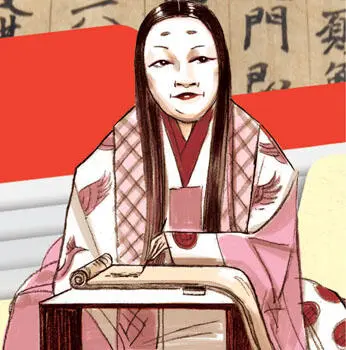
LADY MURASAKI
Murasaki Shikibu, also known as “Lady Murasaki,” was an 11th-century poet and novelist in Japan. She wrote during Japan’s “Heian” period, a golden age of peace, harmony, and the arts. Heian women did not typically learn written Chinese (the language of government in Japan), but Murasaki was anything but typical. She excelled and quickly became a prolific writer of poems and novels in Japanese and is believed to be the world’s first novelist. Her novel, The Tale of Genji , was written in 1007. Many consider it the greatest work of Japanese literature and the oldest full novel in the world. Among other works, she also wrote a volume of poetry entitled The Diary of Lady Murasaki.
Murasaki was married and had a daughter, but her husband died within two years of their marriage. It is believed that because of her incredible writing talent and intelligence, she was brought to live at the royal court. There, she became a lady-in-waiting to Empress Akiko. Murasaki kept a diary about her views on life at court. She used these observations for her novel about daily life among upper class society. The Tale of Genji was immediately successful. It has since been translated into several languages and illustrated editions. To this day, it continues to be studied as the main source of knowledge about life in ancient Japanese society.
| FABULOUS FIRSTS |
 |
WRITER OF THE WORLD’S FIRST NOVEL |
SAINT HILDEGARD OF BINGENIMPORTANT MEDIEVAL COMPOSER AND “INVENTOR” OF OPERA
FULL NAME: Hildegard von Bingen (A.K.A. Sibyl of the Rhine)
BORN: C. 1098, BEMERSHEIM, WEST FRANCONIA (NOW GERMANY)
DIED: 1179, RUPERTSBERG, WEST FRANCONIA (NOW GERMANY)
NATIONALITY: GERMAN
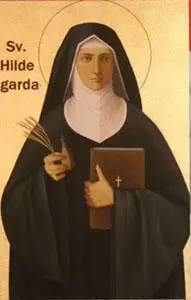
Illustration of Saint Hildegard (date unknown)
INSTRUCTIONS FROM GOD
Hildegard von Bingen achieved many things through devotion to her faith. She became a nun, but she was also a composer, author, preacher, visionary healer-doctor—later a saint. She is also credited as being the inventor of opera. From a young age, Hildegard felt a connection to God. She experienced visions and heard voices. Her parents sent her, aged eight, to live in a convent. As a student of the mother superior, Jutta, Hildegard read and studied widely. When Jutta died, 38-year-old Hildegard was unanimously elected by her fellow nuns to replace her. Her writings became well known, and many nuns came to learn from her. Hildegard knew about medicine and was a great healer. Crowds gathered to have her “miracles” worked on them. She preached widely, even though this was illegal for women. She often challenged senior Church officials and fought for independence. Some of her views on the Church, and on women in society, were progressive. She corresponded with several important figures of the time, many of whom sought her advice, including the German emperor and the English monarchs.
Читать дальше
